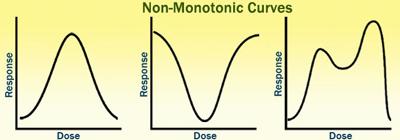Endocrine Disruption Research: Testing for Potential Low-Dose Effects
Issue
There are tens of thousands of chemicals in the environment to which people and wildlife may be exposed. EPA is responsible for investigating endocrine disrupting chemicals and their impacts on people’s health and the environment. Certain chemicals have been found to disrupt the endocrine systems of animals in laboratory studies. Compelling evidence shows that endocrine systems of certain fish and wildlife have been affected by chemical contaminants, resulting in developmental and reproductive problems.
Some of EPA's current chemical testing guidelines require multiple doses (amounts) of a chemical to be evaluated for potential adverse effects. Test results determine whether a chemical leads to adverse effects, such as affecting the reproductive system or causing developmental problems. Test results include dose-response curves which show the relationship between a chemical’s concentration and a health effect (i.e., “the dose makes the poison”). A typical dose response curve shows a greater response in the test subject as the dose of the chemical increases. This type of dose response curve is called monotonic.
Some recent scientific studies have shown evidence of dose response curves that are not monotonic, meaning a response may also be greater at lower doses. These types of dose response curves show non-monotonic dose responses (NMDR). Some studies show NMDRs for effects on the endocrine system. If these studies prove relevant for human or environmental health assessment, there may be implications for current testing and assessment approaches.

EPA Action
An EPA led work group of scientific experts reviewed various studies, and the results were detailed in a draft paper, State of the Science Evaluation: Nonmonotonic Dose Responses as They Apply to Estrogen Androgen, and Thyroid Pathways and EPA Testing and Assessment Procedures, submitted to the National Academy of Sciences on June 18, 2013. The purpose of the paper is to help EPA policy makers determine if NMDRs indicate adverse effects that are not detected using current chemical testing strategies. While EPA is interested in all aspects of NMDR, the paper focuses on endocrine disruptors— in particular estrogen, androgen and thyroid active chemicals.
The National Academies of Science's (NAS) Board on Environmental Studies and Toxicology reviewed the paper to provide an expert peer review and requested public comment. NAS provided their findings and recommendations to EPA on May 2, 2014.
Why does this matter?
EPA depends on NAS for scientific guidance and their recommendations help make EPA’s science stronger. EPA appreciates the rigorous scientific review of this paper and believes the NAS review will greatly improve the scientific soundness of the paper.
Next Steps
EPA is currently reviewing the NAS findings and recommendations to determine the next steps for moving forward with studying NMDR.
